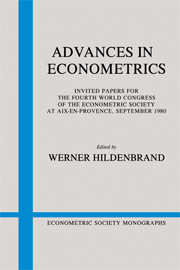Book contents
- Frontmatter
- 1 Qualitative response models
- 2 The identification problem in econometric models for duration data
- 3 The effects of time in economic experiments
- 4 Some recent developments on the distributions of single-equation estimators
- 5 Best uniform and modified Padé approximants to probability densities in econometrics
- 6 Identifiability and problems of model selection in econometrics
- 7 Causality, exogeneity, and inference
- 8 Generating mechanisms, models, and causality
- 9 Comparing alternative asymptotically equivalent tests
- 10 Conflict among testing procedures in a linear regression model with lagged dependent variables
- 11 Macroeconomic modeling based on econometric and simulation models for the Polish economy
3 - The effects of time in economic experiments
Published online by Cambridge University Press: 05 January 2013
- Frontmatter
- 1 Qualitative response models
- 2 The identification problem in econometric models for duration data
- 3 The effects of time in economic experiments
- 4 Some recent developments on the distributions of single-equation estimators
- 5 Best uniform and modified Padé approximants to probability densities in econometrics
- 6 Identifiability and problems of model selection in econometrics
- 7 Causality, exogeneity, and inference
- 8 Generating mechanisms, models, and causality
- 9 Comparing alternative asymptotically equivalent tests
- 10 Conflict among testing procedures in a linear regression model with lagged dependent variables
- 11 Macroeconomic modeling based on econometric and simulation models for the Polish economy
Summary
In the late 1960s and throughout the 1970s an important event has occurred for empirical economists. The United States government and other agencies have adopted the tool of experimentation to investigate important social and economic questions. To date, experiments have been conducted in income maintenance programs, electricity time-of-day prices, housing allowance subsidies, medical reimbursement, and numerous other areas. These experiments have involved major expenditures of economic resources. For instance, the cost of the four negative income tax (NIT) experiments has been in excess of $100 million, and the time-of-day (TOD) price experiments have cost about $25 million. To some extent these experiments have attempted to replicate the methods developed over the past 60 years and applied with outstanding success in many biological and physical sciences. R. A. Fisher's influential work in agricultural experiments, along with the work of many other statisticians, has firmly established the usefulness of experimentation as a tool of scientific inference.
Although I do not intend to judge the overall usefulness of the many economics experiments to date, I think that a fair statement is that they have enjoyed mixed success. Much knowledge has been gained from these experiments, and many low-income individuals have benefited during the course of these experiments. On the other hand, they have not settled the questions that they were designed to answer as definitely as have experiments in the other sciences.3 In this chapter I shall attempt to investigate the reasons for this lack of definite results. One problem that has arisen is that many of these experiments have tried to answer too many questions. That is, the experimental design has contained too many elements for the given size of the budget and for the precision with which econometric models can be estimated.
- Type
- Chapter
- Information
- Advances in Econometrics , pp. 79 - 108Publisher: Cambridge University PressPrint publication year: 1983



